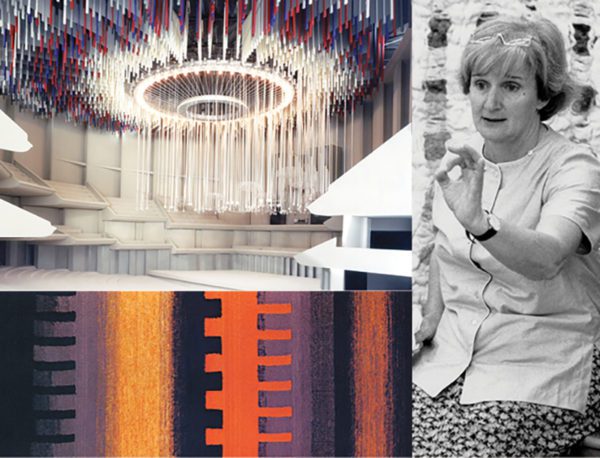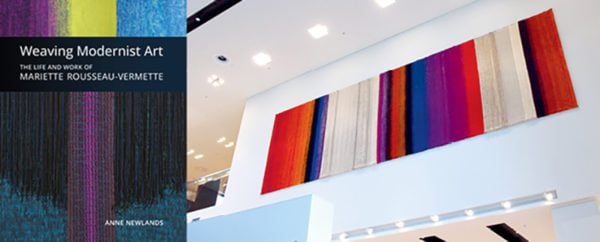
Roy Thomson Hall auditorium model (1980); Mariette Rousseau-Vermette,The Banff Centre c. 1980. (Private Collection); Contrastes (1965). (From Weaving Modernist Art, with permission from Firefly Books.)
As a former educator and researcher-writer at the National Gallery of Canada (NGC), Anne Newlands is all too familiar with the way women’s art has been historically undervalued and under-represented on the walls and in the collections of major art institutions.
Newlands’s first solo-authored book, Canadian Art: From Its Beginnings to 2000, published in 2000 by Firefly Books, offered an ambitious compendium of 300 biographies of Canadian artists, ranging in backgrounds and practices. The Ottawa-based curator and writer returns to Firefly in April with an in-depth look at the career of Quebec textile artist Mariette Rousseau-Vermette (1926–2006), whose large-scale tapestries earned international accolades, but who has never become a recognizable household name despite her many professional achievements.
With its gorgeous full-page colour images accompanied by Newlands’s deeply researched writing, Weaving Modernist Art: The Life and Work of Mariette Rousseau-Vermette offers a well-deserved and passionate tribute to this pioneering artist, who, during her lifetime, was commissioned to design theatre curtains for the National Arts Centre in Ottawa and for the Kennedy Centre in Washington, D.C., among many other works.
“I did have an agenda,” says Newlands. “And that was to put Mariette in the context of her times, but also to argue for her as an artist and not just a craftsperson.”
A 192-page hardcover book of this size and weight doesn’t happen overnight. During the end of her tenure at NGC, working in the gallery’s library before she took early retirement, Newlands was tasked with writing a short biography of Rousseau-Vermette. She rummaged around the limited files on the artist, whom she had never heard of, but “I could see from the little bit that had been written that she’d had this very prolific career, and that she was a star in her lifetime.”
Newlands’s interest in female Canadian artists and love of research was piqued, and she began looking deeper into Rousseau-Vermette as a potential subject for a deeper investigation. “Research is about discovery, and it’s a fun part of that process. I really didn’t know when I embarked on looking into Mariette’s background what I would find,” says Newlands.
In Europe, woven tapestries hold a storied history, whereas North American institutions have been slower to recognize the works of textile artists – painting, sculpture, and, more recently, photography, are still considered the most valued disciplines – with fibre and other craft-based works often considered a secondary art form (another gendered legacy). Yet, even the cover of the book, which features a detail of one of Rousseau-Vermette’s tapestries from the National Arts Centre, with its rich flowing ombré palette of cerulean and violet stripes, touched with a dash of yellow and a dark fringe, reflects her painterly approach to fibre.

Éclat de joie (1969)
Rousseau-Vermette, who grew up in Trois-Pistoles, Quebec, studied textile design and tapestry at the École des beaux-arts de Québec, followed by training and mentorship in San Francisco, California. Her professional training was supplemented by travels to Europe and Japan, which is reflected in her modernist approach to colour, shapes, and instinctual appreciation for physical spaces.
The book covers highlights from the 644 tapestries Rousseau-Vermette created during her lifetime, supplemented by photos of the hundreds of cartons (drawings) and maquettes, which Newlands accessed through support from Rousseau-Vermette’s family, who enthusiastically opened the late artist’s studio for her perusal.
Once Newlands gained access to Rousseau-Vermette’s archives, she was able to stop playing detective, as she had all the material she needed to create a chronological map of the artist’s career. “It was like a gold mine,” she says. The artist had documented all her tapestries, and in the files Newlands discovered more information on all her commissions. “She did about 100 public works,” says Newlands. “She was about the most prolific artist of public works of her generation.”
Firefly committed to providing a thorough photographic experience of the artist’s tapestries for the book, which set Newlands off on another hunt to find suitable images. Although Rousseau-Vermette kept slides of her work, their condition had deteriorated over the decades. Newlands made a valuable connection with an old friend of Rousseau-Vermette’s, an American photographer who had shot photos of all her preparatory drawings. She also relied on photos from the international museums that had taken images for exhibitions, and from the private archives of photographers who had shot commissioned works at places such as Roy Thomson Hall, for which Rousseau-Vermette had created felt banners and more than 2,000 woollen tubes, dripping like stalactites from the ceiling to provide sound absorbency.
The photos of the tapestries in situ offer readers a sense of the massive scale of Rousseau-Vermette’s work and the warm but earthy tones she favoured in her colour palette. “She was a tiny woman, like five foot two, who loved enormous work,” says Newland. “She said very clearly, ‘I like to work big.’ Her favourite projects were tapestries made in collaboration with architects – architectural commissions, big lobbies, theatre curtains. She rose to those challenges, so it’s nice the way the book reflects that because of its own size.”
 Contact us via email
Contact us via email

